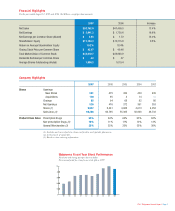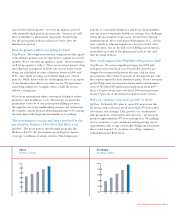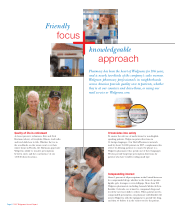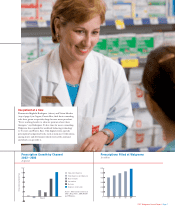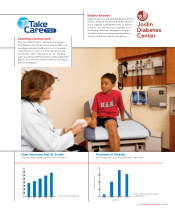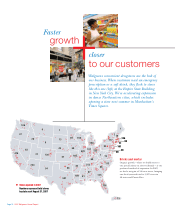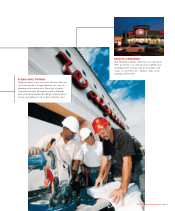Walgreens 2007 Annual Report Download - page 7
Download and view the complete annual report
Please find page 7 of the 2007 Walgreens annual report below. You can navigate through the pages in the report by either clicking on the pages listed below, or by using the keyword search tool below to find specific information within the annual report.
Walgreens acquired a company called Option Care
in August. Why?
Jeff Rein: Acquisitions outside our core business are integral to
our strategy to meet a growing number of health and wellness
needs in a way that’s compellingly easy for patients and lowers
costs for payors. Integration of the Option Care business has
gone very well, and it’s already contributing to our results.
With this purchase, Walgreens is the fourth largest specialty
pharmacy provider in the country and the largest home infusion
provider. As biopharmaceutical research escalates, the specialty
market is projected to grow at a rate of more than 20 percent
a year. Specialty – often called biotech – drugs treat complex
health conditions, such as multiple sclerosis and rheumatoid
arthritis, in new ways. They usually require different delivery
systems – such as infusion or injection – and more patient
education than traditional oral medications.
That’s where acquisitions like Option Care in 2007 and
Medmark in 2006 fit in: Very simply, Walgreens biggest
business is prescription drugs. As drugs move more into
the specialty arena, we will provide them to patients in
whatever setting is appropriate, from their home to their
neighborhood Walgreens.
Above all, we’re a retailer – our convenient stores have served
customers and shareholders well for more than a century. Today,
we’re asking, “Where can – and should – our stores converge
with the needs of our nation’s challenged healthcare system?”
We believe store-based services such as immunizations, treatment
of minor health issues, specialty drug infusion, and disease
and wellness management are just the beginning.
Do you see expansion opportunities outside
the stores?
Greg Wasson: Yes. We’re adding a growing number of Walgreen
pharmacies in hospitals and other medical centers to serve
outpatient prescription needs. Examples include Childrens
Hospital Los Angeles, the Joslin Diabetes Center in Boston,
Northwestern Memorial Hospital in Chicago and Stanford
Hospital & Clinics in Palo Alto, California. We also have
pharmacies on the sites of HIV/AIDS clinics, such as the Desert
AIDS Project in Palm Springs, California, and on the campuses
of large employers, including Toyota Motor Manufacturing in
San Antonio. This concept takes our growth potential to a new
level – far beyond our estimate of 13,000 traditional drugstores.
The fundamentals of our business are very strong, especially
given the aging population and the future pipeline of new
drugs. We have prime real estate … talented, committed people
across all levels…a strong strategy for both organic expansion
and growth beyond our traditional drugstore business…
and a hunger for success.
We’re confident that our strategy will produce ongoing success,
and we will continue to prudently manage this business for
the long-term benefit of all our stakeholders. To our investors,
thank you for your interest and support. And to our 226,000
employees, a special thanks for your continuing efforts to
deliver excellent service to our customers, patients and clients.
Jeffrey A. Rein
Chairman and Chief Executive Officer
Gregory D. Wasson
President and Chief Operating Officer
2007 Walgreens Annual Report Page 5
Happy to help
Halden Chen, a pharmacist in Lincolnshire, Illinois,
thinks he has one of the best jobs in America. “I go
to work with one thought,” he says. “If I can make
my patients happy, then I’m happy.”



